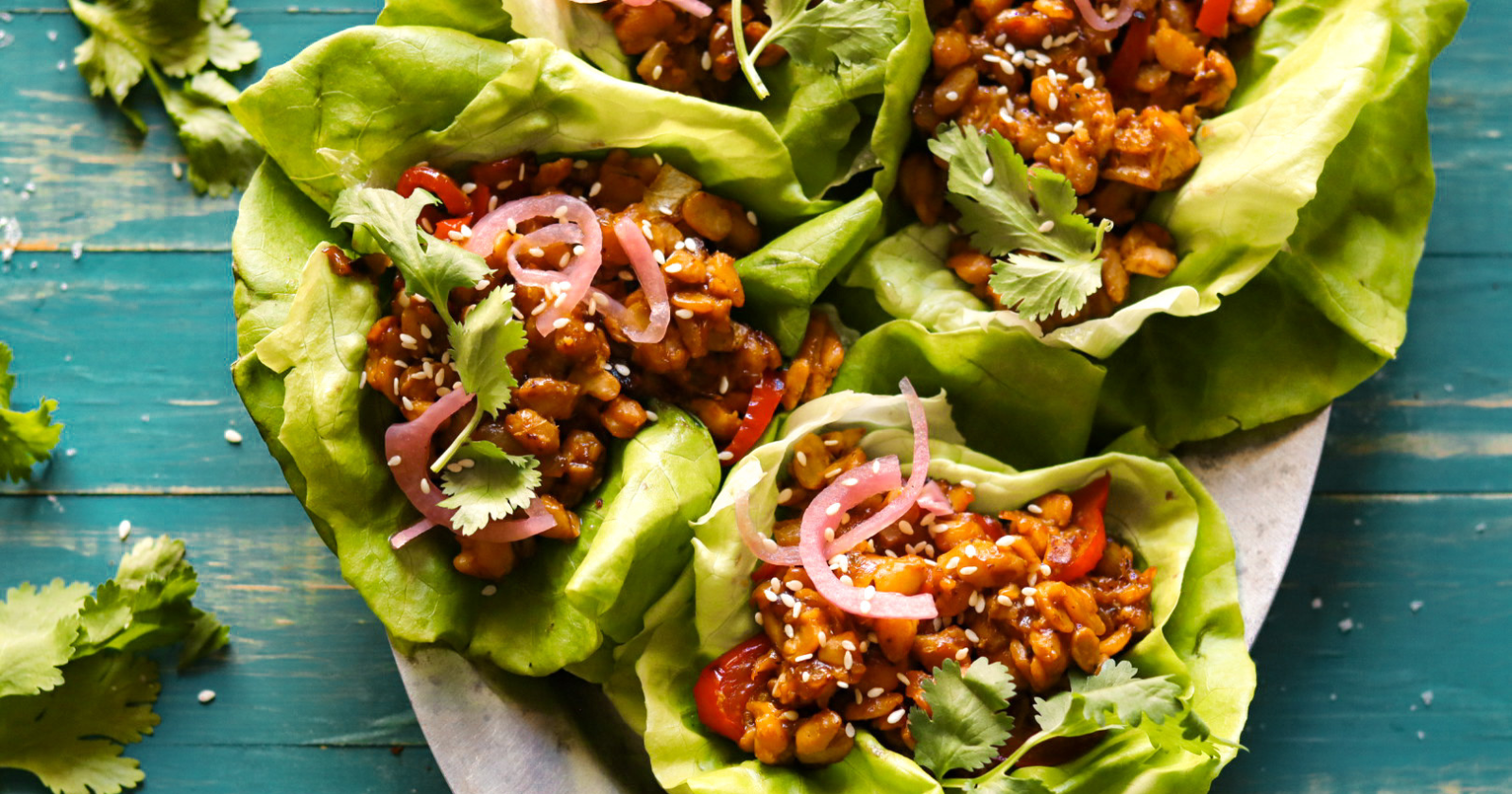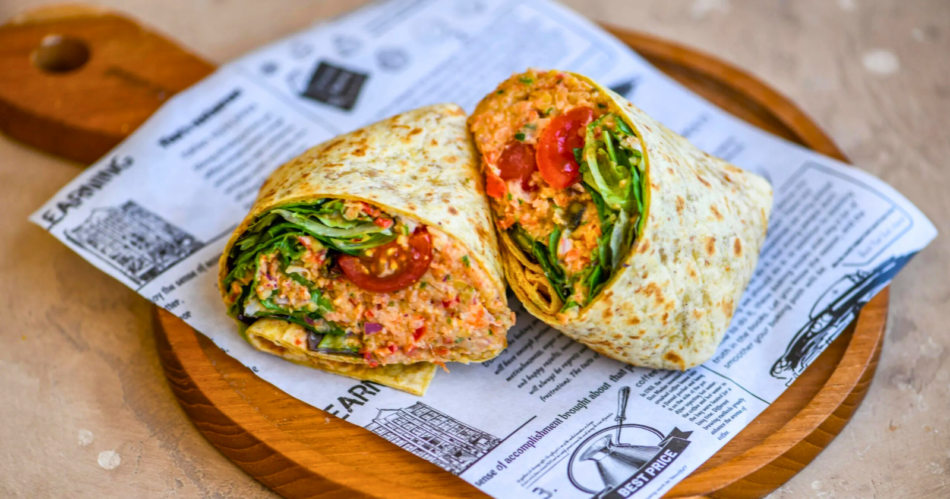We’ve all been there. You’re halfway through the workday, hiking trail, or long drive, stomach growling, and you realize your “healthy” lunch didn’t quite make the cut.
Maybe it wilted, got soggy, or just didn’t fill you up.
If you’ve ever struggled to find plant-based meals that actually keep you energized and survive a few hours outside the fridge, I’ve been right there with you.
I used to pack beautiful vegan lunches that looked great on the counter but by noon, they were a sad mix of mushy veggies and regret.
Through trial, error, and a lot of tinkering, I’ve discovered that the secret to vegan lunches that travel well comes down to two things: protein and structure.
You need meals that fuel you and hold up when life gets busy.
Here are my seven go-to vegan lunches that check both boxes. Each one is rich in protein, satisfying, and built to survive the journey.
1) Chickpea salad wraps
Let’s start with a classic. Chickpeas are one of the best plant-based proteins out there, packed with fiber, iron, and staying power.
I like to mash them with a fork and mix in diced celery, red onion, a spoonful of vegan mayo or mashed avocado, and a splash of lemon juice.
Add a sprinkle of salt, pepper, and maybe some chopped dill or parsley if you’re feeling fancy.
Scoop that into a whole grain wrap with a handful of spinach and you’ve got a protein-packed meal that can handle a few hours in your bag.
Here’s a trick I learned after one too many soggy wraps: layer your greens on both sides of the filling. It creates a barrier so your wrap doesn’t fall apart before lunch.
If you want to switch things up, try using mashed white beans or lentils instead of chickpeas. The texture changes slightly, but the flavor is still fresh and filling.
2) Tofu and veggie grain bowls
When I worked in finance, I used to rely on pre-packaged lunches that cost more than my morning coffee habit. These days, I batch-cook a few grain bowls each week, and they’ve completely changed how I eat on the go.
Tofu is a powerhouse for portable meals. I like to press it, cube it, and roast it until golden with a bit of soy sauce, maple syrup, and garlic.
I pair it with quinoa or brown rice, both great sources of plant-based protein, and roasted vegetables like broccoli, sweet potato, or zucchini.
Drizzle on a sauce that doesn’t separate easily, such as a tahini-lemon dressing or peanut-lime sauce. These hold up better than vinaigrettes, which can make things watery.
The best part is that grain bowls taste even better after sitting a few hours as the flavors blend together. Sometimes I make extra tofu just to snack on later because it’s that good.
3) Lentil shepherd’s pie jars
This one is my secret weapon for long days when I know I won’t be home until late. It’s comfort food that’s practical.
Cooked lentils, either brown or green, mixed with carrots, peas, and onions in a savory tomato-based sauce make the base. Then, top it with mashed potatoes or mashed cauliflower and pack it into a jar or reusable container.
It’s hearty, full of protein and fiber, and perfectly satisfying. You can eat it cold or warm it up if you have access to a microwave.
Once, while volunteering at a farmers’ market, I pulled one of these out for lunch and a few vendors actually asked for the recipe. That’s when I knew I’d found a winner.
4) Tempeh lettuce cups

Tempeh doesn’t always get the love it deserves. I get it, it can taste a little earthy if you don’t prepare it right.
But once you steam or marinate it properly, it transforms into something flavorful and satisfying.
I like to crumble or slice tempeh and sauté it with a bit of tamari, maple syrup, and chili paste for that sweet-spicy balance.
Then, I pack it separately from large lettuce leaves such as romaine or butter lettuce and assemble at lunchtime.
These are light but surprisingly filling. Tempeh has around 18 grams of protein per serving, and since it’s fermented, it’s also great for your gut health.
Sometimes I’ll toss in shredded carrots, sliced cucumber, or edamame for texture. If you want something a bit more substantial, you can wrap the mix in rice paper or tortillas instead of lettuce leaves.
5) Quinoa-stuffed bell peppers
Stuffed peppers are one of those meals that look fancy but are incredibly easy to make. They’re also ideal for traveling.
I like to roast halved bell peppers until tender and fill them with a mix of quinoa, black beans, corn, diced tomatoes, and spices like cumin and smoked paprika.
If I’m in a hurry, I skip the roasting and just eat them raw for a crisp and refreshing meal.
The combination of quinoa and beans makes this a complete protein, which means you get all nine essential amino acids.
For traveling, I pack the filling and peppers separately, then combine them when it’s time to eat.
It prevents the peppers from getting soggy and keeps the flavors bright.
This is also a perfect way to use up leftover quinoa or roasted veggies from dinner.
6) Edamame soba noodle salad
Have you ever tried soba noodles? They’re made from buckwheat, which is gluten-free and high in protein and fiber. Combine that with edamame and you’ve got a satisfying meal that’s light yet filling.
I cook the soba noodles, rinse them under cold water, and toss them with shelled edamame, shredded cabbage, carrots, scallions, and sesame seeds.
For the dressing, I mix rice vinegar, soy sauce, a little maple syrup, and toasted sesame oil.
This salad keeps beautifully in the fridge or a cooler bag and doesn’t clump up the way some pastas do. Plus, the tangy dressing actually improves over time.
One of my favorite things about this dish is that it feels restaurant-quality but takes maybe 20 minutes to make.
I often bring it on road trips because it’s easy to eat on the go and doesn’t need reheating.
7) Hummus and veggie-packed mason jar salads
Let’s finish with a no-cook option. Mason jar salads are an old favorite for a reason. They’re easy to prep, store, and carry without turning into a mess.
Here’s how I layer mine: Bottom: a generous scoop of hummus for bonus protein and flavor. Middle: firm veggies like cucumbers, cherry tomatoes, and shredded carrots. Top: leafy greens or cooked grains like farro or quinoa.
The trick is to keep wet ingredients at the bottom and delicate greens at the top. When you’re ready to eat, just shake the jar or pour it into a bowl and mix.
Sometimes I’ll add roasted chickpeas or baked tofu cubes on top for extra protein crunch.
What I love most about these salads is how flexible they are. You can play with flavors like Mediterranean, Thai, or Southwest just by changing the sauce and add-ins.
Final thoughts
If you’ve ever thought vegan food doesn’t travel well, I promise that’s only half the story. With a little strategy, plant-based meals can be just as sturdy and satisfying as anything else.
The key is balancing protein, texture, and freshness. You want something that holds up in a lunchbox but still feels nourishing when you finally sit down to eat.
I’ve noticed that when I take the time to pack one of these lunches, I’m less likely to grab convenience snacks or make quick food choices that leave me sluggish later.
It’s one small act of preparation that sets the tone for my entire day.
Next time you’re packing lunch, think about what will fuel you and still taste good hours from now. That one question changed how I eat, and maybe it will for you too.
What’s Your Plant-Powered Archetype?
Ever wonder what your everyday habits say about your deeper purpose—and how they ripple out to impact the planet?
This 90-second quiz reveals the plant-powered role you’re here to play, and the tiny shift that makes it even more powerful.
12 fun questions. Instant results. Surprisingly accurate.








